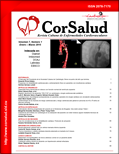Total arterial revascularization with left internal mammary artery
Abstract
A 65-year-old male patient, with a history of insulin dependent diabetes mellitus, hypertension, ischemicheart disease and smoking, underwent a coronary angiography that showed proximal and distal lesions in the left anterior descending artery, and proximal in the diagonal branch (Panel A, arrows). It was decided to perform a coronary artery bypass graft surgery, on a beating heart, without the use of cardiopulmonary bypass. The left internal mammary artery (LIMA) was dissected, skeletonized, to obtain its maximum length and preserve sternal perfusion (Panel B, the left arrow shows the preserved mammary vein and the right arrow the skeletonized LIMA). Sequential grafts were performed: first a laterolateral anastomosis to the first diagonal artery, and then, by jumps, a laterolateral anastomosis to the middle segment of the anterior descending artery. Finally, an endside anastomosis to the distal segment of the anterior descending artery was performed, achieving complete arterial revascularization with the use of a LIMA (Panel C, the clamps show the site of the three sequential grafts). Six months later, the patient continued showing a satisfactory outcome.
Downloads
Download data is not yet available.
Downloads
Published
2015-01-08
How to Cite
1.
Osorio Gómez CM, Vázquez Roque FJ, Medrano Plana Y. Total arterial revascularization with left internal mammary artery. CorSalud [Internet]. 2015 Jan. 8 [cited 2025 Aug. 22];7(1). Available from: https://revcorsalud.sld.cu/index.php/cors/article/view/2
Issue
Section
IMAGES IN CARDIOLOGY
License
Authors who publish with this journal agree to the following terms:- Authors retain copyright and grant the journal right of first publication with the work simultaneously licensed under a Creative Commons Attribution License that allows others to share the work with an acknowledgement of the work's authorship and initial publication in this journal.
- Authors are able to enter into separate, additional contractual arrangements for the non-exclusive distribution of the journal's published version of the work (e.g., post it to an institutional repository or publish it in a book), with an acknowledgement of its initial publication in this journal.










